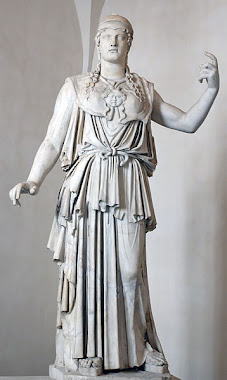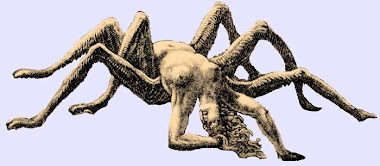Athena
Birth of Athena
Although Metis was of an earlier generation of the Titans, Zeus became her consort when his cult gained dominance. In order to avoid a prophecy made when that change occurred, that any offspring of his union with Metis would be greater than he, Zeus swallowed Metis to prevent her from having offspring, but she already was pregnant with Athena. Metis gave birth to Athena and nurtured her inside Zeus until Zeus complained of headaches and called for Hephaestus to split open his head with his smithing tools. Athena burst forth from his forehead fully armed with weapons given by her mother. She famously wields the thunderbolt and the Aegis, which she and Zeus share exclusively.
http://en.wikipedia.org/wiki/Athena#MythologyCharacteristics
CHARACTERISTICS OF ATHENA
Athena’s birth allegorically proclaims her essential character: her divine wisdom drawn from the head of god; the special bond of affection between father and daughter; her championship of heroes and male causes, born as she was from the male, and not from a mother’s womb. A dread goddess of war, she remained a virgin.
She is a goddess of many other specific arts, crafts, and skills (military, political, and domestic), as well as the deification of wisdom and good counsel. She is skilled in the taming and training of horses, interested in ships and chariots, and the inventor of the flute. This latter invention was supposed to have been inspired by the lamentations (accompanied by the hiss of serpents) uttered by the surviving Gorgons after the death of Medusa. But Athena quickly grew to dislike the new instrument because her beautiful features became distorted when she played, and so she threw it away in disgust. Marysas, the satyr, picked up the instrument with dire consequences. In Athens, Athena was worshiped along with Hephaestus as patroness of all arts and crafts.
APPEARANCE OF ATHENA
Athena bears an aloof kind of loveliness, akin to the beauty of youthful masculinity. She is associated with the owl and the snake. She is usually represented with helmet, spear, and shield or aegis that bore a depiction of the head of Medusa. With her there may be a female winged figure (called NIKE, “victory”), bearing a crown or garland of success. Athena herself as victorious war goddess was called Athena Nike and the simple but elegant temple of Athena Nike stands to the right of the entrance to the Acropolis.
http://www.oup.com/us/companion.websites/9780195397703/student/materials/chapter8/?view=usa
Athena

Arachne

Gustav Dore
ATHENA AND ARACHNE
http://www.oup.com/us/companion.websites/9780195397703/student/materials/chapter8/?view=usa
Representation in Art
THE PANATHENAEA OR PANATHENAIC FESTIVAL
The PANATHENAEA was an annual festival celebrating the birthday of Athena; every fourth year the celebration of the Great Panathenaea was especially splendid. Important in the ceremonies were sacrifices and games; the prizes for winners in the games were special Panathenaic amphoras—vases inscribed and decorated with a depiction of Athena and containing sacred olive oil. A Panathenaic procession wound its way through the city ending with the presentation of an embroidered robe (peplos) to Athena on the Acropolis. Athenians (young and old, male and female) carrying sacred implements, leading sacrificial animals, with chariots or on horseback, figured in the procession.
THE PARTHENON AND ITS SCULPTURE
The PARTHENON is the great temple to Athena Parthenos on the Acropolis of Athens that was built in the fifth century B.C. PARTHENOS, an adjective meaning "virgin," was a standard epithet of Athena. It is a most beautiful Doric temple (even in its ruined state today), and its sculpture (created under the aegis of the great Athenian sculptor Pheidias) bears tribute to Athena herself and her city and all that they mean forever.
-East pediment: the dramatic moment of the birth of Athena, who stood in the center before the throne of Zeus, from whose head she had just spring, fully grown and fully armed. Other divine figures are present at the miracle. At the corners, the horses of Helius (the Sun) and those of Selene (the Moon) set the momentous event in cosmic time.
-West pediment: the contest between Athena and Poseidon, described above; these two central figures pull away from each other as they produce the gifts with which they vie. On either side, figures of Athenian divinities and heroic kings are witnesses.
-Doric frieze: on the exterior are metopes (relief sculpture) depicting four subjects: the battle between the Lapiths and the Centaurs; the sack of Troy; the Gigantomachy; and the battle between the Greeks and the Amazons.
-Ionic frieze: in the interior, on the outer wall of the naos (or cella), continuous relief sculpture renders the splendid Panathenaic procession described above. Athenian men and women are shown as marshals, attendants, horsemen, hoplites and assistants in the worship, along with the animals of ritual sacrifice. At the climax the ceremonial robe is presented to a priestess of Athena while, on either side, enthroned Olympian deities witness the joyous celebration of civic piety.
-The Athena Parthenos: this monumental statue of Athena stood in the cella (or naos). The surfaces of the standing goddess were made of gold and ivory and she held a figure of Nike (Victory) in her right hand; she wore a helmet and the aegis with the head of Medusa, and a spear and shield are at her side; elaborate decorative reliefs enhanced the statue, which has not survived.
http://www.oup.com/us/companion.websites/9780195397703/student/materials/chapter8/?view=usa